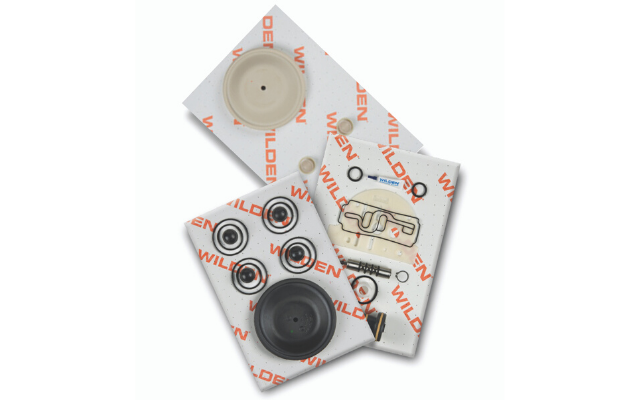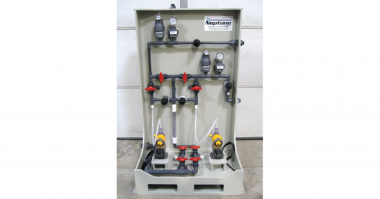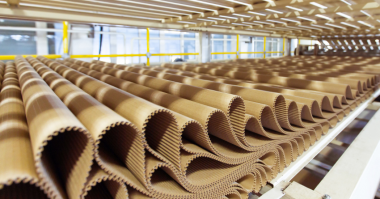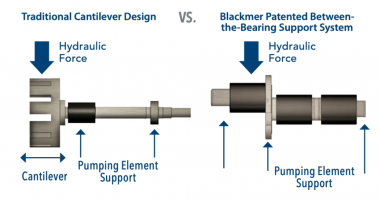Users knockoffs masquerading as genuine branded parts can compromise performance and safety
By John Wallace, Sales Director US & Canada, Diaphragm Group, PSG®
In the world of industrial manufacturing, it’s no exaggeration to say that the air-operated double-diaphragm (AODD) pumping principle – which was invented in 1955 – has been a godsend. Once the capabilities of AODD pumps were established, they became a first-choice technology for operators in numerous industries. Concurrently, the AODD’s success also opened the door for competitors to flock to the market and attempt to emulate, or improve upon, the original design.
Let’s make something clear at this point: there is nothing wrong with legitimate competition, with good-faith efforts made to advance the technology and satisfy the best interests of the user. Competition can also serve as the catalyst that drives the pursuit of even greater product innovation.

Parts that arrive in simple plastic bags with the name and part number written in marker are a sure indication that they have most likely been pirated.
On the other hand, it’s the illegitimate competition that creates cause for concern.
In recent years, a number of “knockoff” AODD-pump companies have entered the market. These companies are pirating pump components and accessories and selling them to unsuspecting customers as genuine branded parts. This report will offer a “Let the buyer beware” look at how these companies are attempting to capitalize on the good name and reputation of established AODD-pump manufacturers, and how users can identify a pirated part and avoid the potentially costly mistake of purchasing and using them.
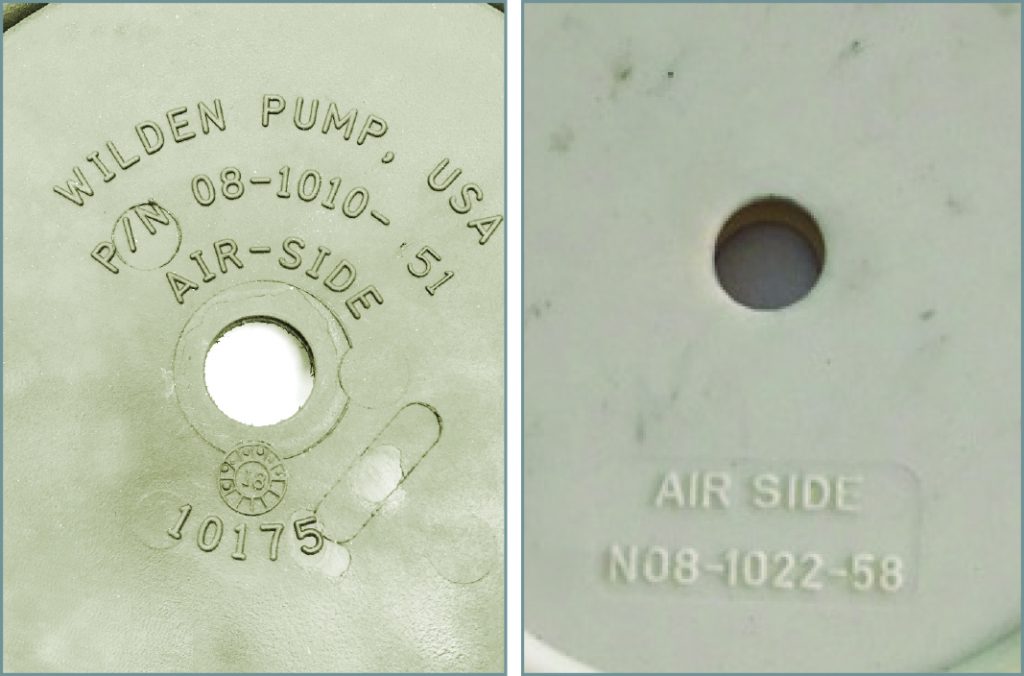
An obvious differentiator between genuine (left) and pirated (right) parts is the presence of a “Manufacturing Date Stamp.” Genuine parts will have the date the part was manufactured stamped on the exterior, along with the brand name and proper part number, while pirated parts will not.
The Wages Of Sin
The true genius of the AODD-pump design is the machine’s simplicity of operation. Despite that, AODD pumps require a series of parts and components to work in perfect harmony – and meet well-established standards for operation – in order for the pump to perform as expected.
The list of AODD-pump parts that the user must be familiar with include the pump body (metal or plastic), diaphragms, pistons, valve balls, valve seats, valve seat O-rings and the Air Distribution System (ADS). Within the ADS, or air motor, the center block, air valve and air control spool are the most significant parts.
However, as the design of AODD pumps has matured, and the list of industries in which they are used has expanded, it is no longer possible to just order, for instance, a “diaphragm.” Different designs and materials of construction have increased the available options for the user. This has also increased the complexity of the ordering and supply process. The result is that AODD-pump users must be finely tuned into the needs of their machines – increasing the importance in using genuine parts when outfitting their pumps.
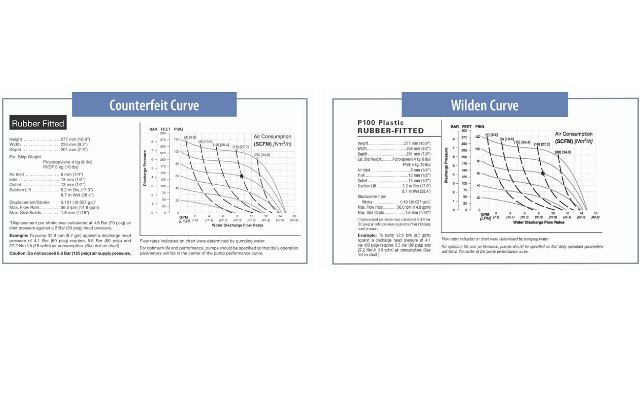
The manufacturers of pirated parts will oftentimes create a “cut and paste” reproduction of the part’s performance information that comes straight from the manual of the original manufacturer. In this example, there’s no real difference between the flow curve for the pirated part, on the left, and the authentic OEM version, on the right, but their actual performance will vary greatly.
As mentioned, AODD pumps only operate at peak performance when the proper original equipment manufactured (OEM) or approved components are used. Failure to use the proper components can result in:
- Voided warranty: If the pump fails and is found to be outfitted with a knockoff part rather than a genuine OEM part, the warranty can be voided. This can result in the user footing the bill for any repairs or the purchase of a new pump
- Lower flow rates: Satisfying demanding production schedules is a front-of-mind concern for all manufacturers and components that may not meet strict design standards will not perform as expected. This can mean minimized production rates, along with higher operational costs that are brought on by the need for increased operational time.
- More frequent breakdowns: Again, pirated parts are not subject to OEM quality-control standards and will be more susceptible to breakdowns that can lead to increased downtime, maintenance costs and repair costs
- Reduced operational safety: Using a non-OEM part can jeopardize chemical compatibility and even worker safety. In other words, you just can’t be sure what you’re actually getting if it isn’t a genuine part – and you shouldn’t be willing to take that risk.
Know The Warning Signs
Unfortunately, the entry of pirated parts into the AODD-pump market has become a fact of life. While these parts may try to capitalize on the reputation of the OEM, they are obviously inferior and unable to deliver OEM-level performance. Knowing that, these unscrupulous suppliers attempt to “trick” users by mimicking the brand or referencing specific part names, numbers and performance curves.

Genuine OEM replacement parts will be packed in a heavy-duty plastic bag with the company name, a “genuine parts” notation and the company address embossed on the front with the part number and quantity clearly indicated.
There are a number of ways, though, that these pirated parts can be recognized:
- Part numbers that are not typical for the brand. The most common example of this phenomenon is an almost identical part number. For instance, a typical OEM part number for a diaphragm maybe 08-1022-58. To confuse the situation or appear to be same-for-same, the counterfeit replacement model available (that claims to be genuinely OEM-manufactured), has a similar part number that begins N08 or PF08, with the “N” and “PF” representing the first letter(s) of the knockoff company’s name.
- Missing critical identification marks. Diaphragms and most other parts made by the OEM usually include a “Manufacturing Date Stamp” clearly shown on the part. These stamps identify the brand and part number, along with indicating the month and year in which the part was manufactured.
- Parts shipped in non-traditional or atypical packaging: Genuine OEM aftermarket parts (most notably Spare Parts Kits) are typically packaged in some form of sealed container that features the brand name. Replacement parts ordered outside of a parts kit will likely be shipped in plastic bags. In the example shown in illustration A (show two bags side-by-side, one Wilden and one Pirated) the OEM bag should have the company name, address/contact information and other identifying marks, along with the part number and quantity, printed on it. Some brazen piraters are shipping individual parts in simple plastic bags with the part name and number written with a marker and nothing else. Receiving parts in this manner should raise red flags. Most brands have also taken many years to cultivate and refine a unique logo and color scheme. So, if a set of replacement valve balls arrives in a package where the brand name is written in an unfamiliar color or font, there’s a good chance the parts have been pirated.
- Parts that claim to be constructed of a certain material, but may not be: It’s easy for a counterfeiter to say that a diaphragm is constructed of a brand-specific material – and to the untrained eye, that claim may be hard to refute. Every company will offer a variety of diaphragms in blends of different materials. These blends have been extensively tested so that they will maximize pump life, minimize startup pressure and ensure easy installation. Pirated diaphragm sellers may cut corners to save time and money by using materials that have are sub-standard in specific applications. Also keep in mind that a true OEM-produced diaphragm will have the company logo stamped on the back along with the part number, while the pirated part will not. All of this is important because operating a pump in an application that requires a specific material when the diaphragm is, in fact, not constructed of that material can lead to increased downtime, maintenance costs and replacement costs, as well as a reduced level of safety where chemical compatibility is critical to the operation.
- Fake documentation. Before any of their products are released, OEMs carefully field and factory test them, and then publish the performance data in the manuals that are shipped with each part. Some pirates attempt to duplicate OEM manuals, right down to the use of matching font styles and performance-curve formats. In fact, some counterfeiters will literally “cut and paste” an OEM manual’s graphics into their own IOMs instead of conducting legitimate performance tests. See illustration B to compare the original flow curve (left) to a counterfeit flow curve (right). Showing identical specs to the OEM indicates a lack of testing on the part of the pirate.
Still, it’s likely that some of the more sophisticated counterfeiters may be able to replicate the look and feel of OEM packaging and part-number nomenclature. This will make it more difficult to readily identify a pirated part. In this case, the user will have to pay close attention to the pump’s performance after any replacement parts have been installed.
Simply put, the machine will not be able to deliver the level of performance that is expected when it is outfitted with a non-OEM part.
At this point, it’s important to reiterate the dangers that can be created for the operator if AODD pumps are not equipped with genuine OEM parts. Foremost are breakdowns or malfunctions that can compromise the safety of the operation, site personnel and technicians, and surrounding communities and the environment. This is a risk that should not be taken in the name of saving a few dollars through the use of non-standard knockoff parts – especially if it means that a warranty will be voided.
Conclusion
Imitation may be the highest form of flattery, but pirated parts will always be the bane of legitimate operators in any industry. Through a combination of awareness and due diligence, the users of branded AODD pumps can take the sting out of the knockoff-parts market, and ensure the safe, reliable and efficient operation of their equipment. The overriding lesson here is simple: Always buy genuine OEM parts either directly from the manufacturer or from an authorized distributor or sales representative that is listed on the manufacturer’s website.
About the Author:
John Wallace is the Sales Director US & Canada, Diaphragm Group for Wilden® and PSG®. He can be reached at john.wallace@psgdover.com. Based in Grand Terrace, CA, USA, Wilden is the global leader in air-operated double-diaphragm (AODD) pumps and a product brand of PSG, a Dover company. Headquartered in Oakbrook Terrace, IL, USA, PSG is comprised of several of the world’s leading pump brands, including Abaque™, All-Flo, Almatec®, Blackmer®, Ebsray®, Griswold®, EnviroGear®, Mouvex®, Neptune™, Quattroflow™, RedScrew™ and Wilden®. For more information on Wilden or PSG, please go to wildenpump.com or psgdover.com.

